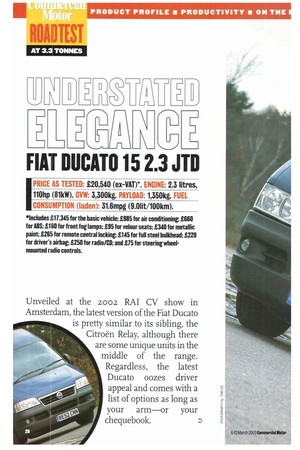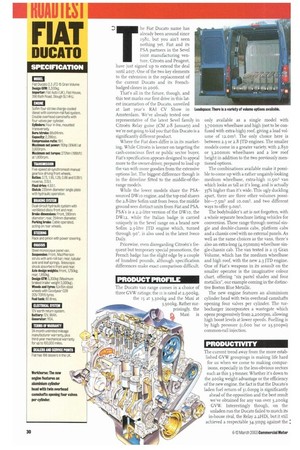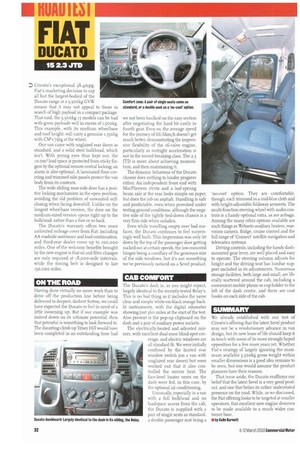FIAT DUCAT° 152.3 JTD
Page 28

Page 30

Page 32

If you've noticed an error in this article please click here to report it so we can fix it.
IPRICE AS TESTED: £20,540 (ex-VAT)*. ENGINE: 2.3 litres, 110hp (81kW). GYIY: 3,300kg. PAYLOAD: 1,350kg. FUP CONSUMPTION (laden): 31.6mpg (9.01it/100km).
*Includes £17,345 for the basic vehicle; £985 for air conditioning; £660 for ABS; £160 for front fog lamps; 195 for velour seats; 1340 for metallic paint; £265 for remote central locking; 1145 for full steel bulkhead; 1220 for driver's airbag; 1250 for radio/CD; and £75 for steering wheelmounted radio controls.
Unveiled at the 2002 RAT CV show in Amsterdam, the latest version of the Fiat Ducato is pretty similar to its sibling, the Citroen Relay, although there are some unique units in the middle of the range. Regardless, the latest Ducato oozes driver appeal and comes with a list of options as long as your arm—or your chequebook. The Fiat Ducato name has already been around since 1981, but you ain't seen nothing yet. Fiat and its PSA partners in the Sevel joint manufacturing venture, Citroen and Peugeot. have just signed up to extend the deal until 2017. One of the two key elements to the extension is the replacement of the current Ducato and its Frenchbadged clones in 2006.
That's all in the future, though, and this test marks our first drive in this latest incarnation of the Ducato, unveiled at last year's RAI CV Show in Amsterdam. We've already tested one representative of the latest Sevel family in Citroen Relay guise (CM 2-8 January) and we're not going to kid you that this Ducato is a significantly different product.
Where the Fiat does differ is in its marketing. While Citroen is keener on targeting the cash-conscious fleet or public sector buyer, Fiat's specification appears designed to appeal more to the owner-driver, prepared to load up the van with more goodies from the extensive options list. The biggest difference though is in the driveline fitted to the middle-of-therange models.
While the lower models share the PSAsourced DWio engine, and the top end shares the 2.8-litre Sofim unit from Iveco, the middle ground sees distinct units from Fiat and PSA. PM's is a 2.2-litre version of the DWio, the DW12. while the Italian badge is carried uniquely in the Sevel range on a brand new Sofia' 2.3-litre ITD engine which, turned through 90°. is also used in the latest lveco Daily.
Pricewise. even disregarding Citroen's frequent but temporary special promotions, the French badge has the slight edge by a couple of hundred pounds, although specification differences make exact comparison difficult.
PRODUCT PROFILE
The Ducato van range comes in a choice of three GVW ratings; the it is rated at 2,900kg,
the 15 at 3,300kg and the Maxi at 3,500kg. Rather surprisingly, the Maxi is only available as a single model with 3,7oomm wheelbase and high (not to be confused with extra-high) roof, giving a load volume of 12.om3. The only choice here is between 2.3 or 2.8 JTD engines. The smaller models come in a greater variety, with 2,850 or 3,2oomm wheelbases and a low roof height in addition to the two previously mentioned options.
The combinations available make it possible to come up with a rather ungainly-looking medium wheelbase, extra-high 11.5m3 van which looks as tall as it's long, and is actually 35% higher than it's wide. This ugly duckling apart, there are three other volumes possible-7.5m3 and ro.om3. and two different ways to offer 9.om3.
The bodybuilder's art is not forgotten, with a whole separate brochure listing vehicles for conversion. These range through normal single and double-chassis cabs, platform cabs and a chassis cowl with no external panels. As well as the same choices as the vans, there's also an extra-long (4,050mm) wheelbase single-chassis cab. The van tested is a 15 Gran Volume, which has the medium wheelbase and high roof, with the new 2.3 JTD engine. One of Fiat's weapons in its assault on the smaller operator is the imaginative colour chart, offering "six pastel shades and four metallics", our example coming in the distinctive Boston Blue Metallic.
The new engine features an aluminium cylinder head with twin overhead camshafts opening four valves per cylinder. The turbocharger incorporates a wastegate which opens progressively from 2,200rpm, allowing high boost levels at lower speeds. Fuelling is by high pressure (1,600 bar or 23,500psi) common-rail injection.
PRODUCTIVITY
The current trend away from the more estab lished GVW groupings is making life hard for us when we come to making comparisons, especially in the less-obvious sectors such as this 3.3-tonner. Whether it's down to the 200kg weight advantage or the efficiency of the new engine, the fact is that the Ducato's laden fuel return of 31.6mpg is significantly ahead of the opposition and the best result we've obtained for any van over 3,200kg GVW. Interestingly though, on the unladen run the Ducato failed to match its in-house rival, the Relay a.zHDi, but it still achieved a respectable 34.mpg against the :
D citron's exceptional 38.4mpg. Fiat's marketing decision to cap all but the largest-bodied of the Ducato range at a 3,300kg GVW means that it may not appeal to those in search of high payload in a compact package. That said, the 3,300kg 13 models can be had with gross payloads well in excess of f,5ookg. This example, with its medium wheelbase and roof height, will carry a genuine 1,35ok8 with CM s 75kg at the wheel.
Our van came with unglazed rear doors as standard, and a solid steel bulkhead, which isn't. With prying eyes thus kept out, the io.oni3 load space is protected from sticky fingers by the optional remote central locking; an alarm is also optional. A laminated floor covering and trimmed side panels protect the van body from its contents.
The wide sliding near-side door has a positive locking mechanism in the open position, avoiding the old problem of unwanted selfclosing when facing downhill. Unlike on the longest wheelbase version, the door on the medium-sized version opens right up to the bulkhead, rather than a foot or so back.
The Ducato's warranty offers two years unlimited mileage cover from Fiat, including AA roadside assistance and load continuation, and third-year dealer cover up to ioo,000 miles. One of the welcome benefits brought by the new engine is that oil and filter changes are only required at 18 ,000-mile intervals. while the timing belt is designed to last 15o.000 miles.
ON THE ROAD Having done virtually no more work than to drive off the production line before being delivered to deepest, darkest Sutton, we could have expected the Ducato to feel in need of a little loosening up. But if our example was indeed down on its ultimate potential, then that potential is something to look forward to. The daunting climb up Titsey Hill would have been completed in an outstanding time had we not been baulked on the easy section after negotiating the hard bit easily in fourth gear. Even so, the average speed for the journey of 6 6.61cm/h doesn't get much better, demonstrating the impressive flexibility of the i6-valve engine, particularly as outright acceleration is not in the record-breaking class. The 2.3 JTD is more about achieving momentum, and then maintaining it.
The dynamic behaviour of the Ducato chassis does nothing to hinder progress either. An independent front end with MacPherson struts and a leaf-sprung beam axle at the rear looks simple on paper, but does the job on asphalt. Handling is safe and predictable, even when provoked under testing ground conditions, although the negative side of the tightly tied-down chassis is a very firm ride when unladen.
Even while travelling empty over bad surfaces, the Ducato continues to feel surprisingly well built. This impression was only let down by the top of the passenger door getting sucked out at certain speeds, the low-mounted hinges being a corollary of the generous size of the side windows, but it's not something we've previously noticed on a Sevel product.
CAB conowoRT The Ducato's dash is, as you might expect, largely identical to the recently-tested Relay's. This is no bad thing as it includes the same clear and simple white-on-black orange backlit instruments, with the digital odometer showing just 360 miles at the start of the test. Also present is the pop-up clipboard on the dash and a pair of auxiliary power sockets.
The electrically-heated and adjusted mirrors, with excellent dual-zone blind-spot coverage, and electric windows are all standard fit. We were initially confused by the heated rear window switch (on a van with unglazed rear doors) but soon worked out that it also controlled the mirror heat. The face-level heater vents on the dash were fed, in this case, by the optional air conditioning.
Unusually, especially in a van with a full bulkhead and no loadspace access from the cab, the Ducato is supplied with a pair of single seats as standard, a double passenger seat being a `no-cost' option. They are comfortable, though, each trimmed in a mid-blue cloth and with height-adjustable foldaway armrests. The multi-function steering wheel with audio controls is a handy optional extra, as are airbags. Among the many other options available are such things as Webasto auxiliary heaters, rearvision camera, fridge, cruise control and the full range of 'Connect' satellite navigation and telematics systems.
Driving controls, including the handy dashmounted gear lever, are well placed and easy to operate. The steering column adjusts for height and the driving seat has lumbar support included in its adjustments. Numerous storage facilities, both large and small, are liberally scattered around the cab, including a convenient mobile phone or cup holder to the left of the dash centre, and there are coat hooks on each side of the cab.
SUMMARY
We already established with our test of Citroen's offering that the latest Sevel product may not be a revolutionary advance in van design, but its new lease of life should keep it in touch with some of its more strongly hyped opposition for a few more years yet. Whether Fiat's strategy of largely ignoring the maximum available 3,500kg gross weight within smaller dimensions is a good idea remains to be seen, but one would assume the product planners have their reasons.
That issue aside, the Ducato reaffirms our belief that the latest Sevel is a very good product, and one that belies its rather understated presence on the road. While, as we discussed, the Fiat offering looks to be targeted at smaller operators, that excellent new engine deserves to be made available to a much wider customer base.
• by Coln Barnett




































































































































































